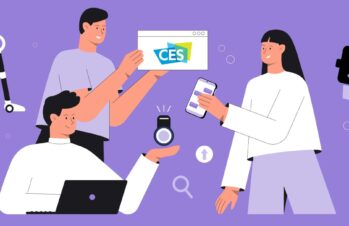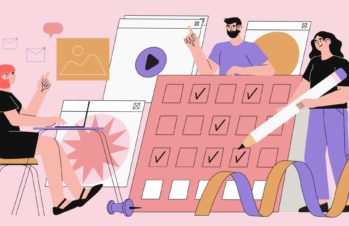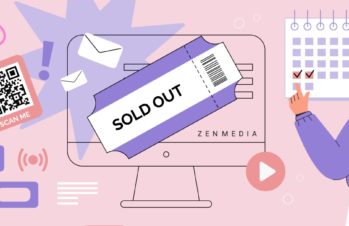Event marketing and experiential marketing are sometimes seen as the same thing.
However, while experiential marketing is designed to create a two-way engagement with the customer, in which the brand and customer engage in a dialogue, event marketing refers to opportunities like trade shows, product demos, brand-sponsored conferences, panels, and more—either virtual or in-person.
Events like these can be critical for B2B businesses, as industry networks are so important to success. So how can you ensure that you’re not only giving potential customers everything they need to choose your brand over your competitor? Not only that, but how can you then measure your event success?
What is B2B event marketing?
B2B event marketing is a form of marketing where businesses invite other businesses to attend events in order to network and learn about new ideas and technologies. The goal of these events is to increase sales leads and revenue through networking opportunities and to bring together business owners from different industries who may be interested in learning about each others’ products and services.
Tips to consider for effective B2B event marketing
B2B events are great for generating leads and building relationships. The key is to create a memorable experience for attendees. To do this, you need to plan carefully and be creative. Here are some tips:
- Make sure all details are planned out ahead of time
- Have a clear call to action at the end of each session.
- Provide freebies like pens, business cards, etc.
- Create a follow up email after the event.
- Use video recordings of sessions.
- Offer incentives such as discounts or free trials.
- Send thank you notes to participants.
- Keep track of who attended and send them emails periodically.
- Don’t forget about LinkedIn!
What goes into a successful B2B event marketing campaign?
Putting together a successful B2B event marketing campaign involves several steps.
- Identifying your audience, accounting for both prospects and existing customers.
- Establishing goals and KPIs.
- Developing your speaker and/or sponsor list.
- Creating your promotional plan, including email marketing, content, and social media.
- Monitoring social mentions during the event.
- Post-event analysis and evaluation.
Identify your audience.
Determine whom your event is targeting. This will depend on the type of event you’re hosting, and what you’re trying to achieve with it.
If it’s a product demo at a trade show, your audience will likely be mostly new customers who are also attendees at the trade show. It could also be reporters, bloggers, and industry experts.
If it’s a virtual conference, on the other hand, your audience may be more wide-ranging. There are your current customers, potential customers, others in the industry, and people from other industries who may be interested in the topic or purpose of the conference.
Once you’ve established whom you want to reach, segment your audience types out so you can develop messaging geared toward each group.
Establish your goals and KPIs.
What are your goals with this event? Get more specific than just “raising awareness” or “expanding our brand reach.”
Do you have a set number of registrations you want to achieve, or a number of product sales you want to make?
Do you want to increase your prospect list by X percent?
Write these down and decide with your team which goals are most important, and how you’ll measure them. You’ll need the right tools: Google Analytics, a social listening tool, and possibly a PR analytics platform like Cision or Meltwater.
Develop your speaker list.
If you’re hosting an event that includes speakers, like a panel or a conference, you’ll want to strike a balance: you’ll want people who can speak on topics your audience is interested in, as well as who have an engaged following.
There’s no need to seek out mega influencers to draw a big crowd. In fact, mega influencers often draw less engagement than those who cover a more specific niche.
Create your promotional plan, including email marketing, content, and social media.
In the weeks leading up to your event, you’ll need to include a variety of different outreach tactics.
Email marketing should be a top priority, as you’ll want to send out multiple emails leading up to the event (and afterward) to your segmented audience. Typically, there should be:
- An announcement email with a link to pre-registration
- A follow-up email once the regular registration period opens
- A reminder email about your event listing speakers, panels, and any other details that were previously TBA
- A post-event email to attendees asking for feedback, sharing takeaways, and including a call to action to follow you on social, sign up for your newsletter, or download a piece of content (choose just one!).
Content-wise, you can write a blog post about the event, create a short video where you explain what will happen and ask people to sign up, and go live on your social networks to announce the event, share updates on your speaker list, and/or answer questions.
For social media, you should be posting about the event regularly to share details. A good practice is to create an event-specific hashtag, and use it on every event-related post you share. Encourage your followers to do the same.
Monitor social mentions during the event.
During your event, have at least one staff person assigned to monitor social media mentions of your event and speakers. They should be tracking not only your event hashtag, but also other keywords related to your event and what your speakers are posting.
Analyze and evaluate your event once it’s complete.
Once your event is over and done with, it’s time to look at your analytics. Based on the KPIs you set initially, you can determine how well you did in terms of meeting each B2B event marketing goal.
The analytics will give you the quantitative feedback you need to improve your next B2B event marketing campaign. But it’s also important to get qualitative feedback from your attendees. You can do this by sending out a survey to attendees, emailing speakers personally to get their thoughts, or sending out a request for feedback to any private online networks you have.
How does B2B event marketing with our agency work?
At Zen, we take a holistic approach to B2B event marketing, starting from the very beginning. We handle all of the steps mentioned above.
If you’re putting on a conference, we can handle everything from finding a venue, to booking speakers.
If it’s a pop-up product demo, we’ll work with you to find a suitable location and employ the latest marketing technologies, like location-based targeting, to bring people in.
While your event is happening, we track online mentions and user-generated content, and amplify both to ensure you get the greatest possible reach.
And we don’t stop once the event is over. Afterward, we analyze the agreed-upon KPIs as well as the B2B marketing event’s digital footprint and hard data like the percent increase in sales, newsletter sign-ups, etc.
Our goal is to give you not just a successful B2B event marketing campaign, but a clear idea of why it was successful, and how that can be replicated.
Sound like something your brand could use? Get in touch today!








